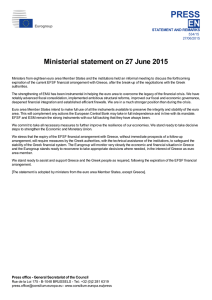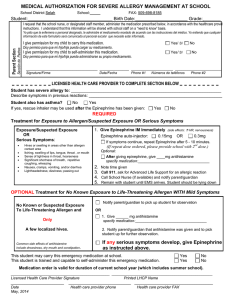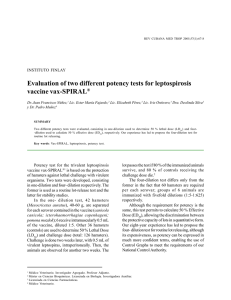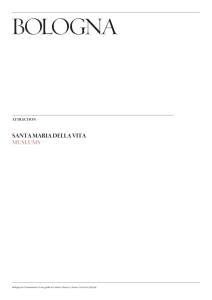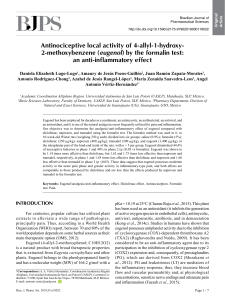2015 Dec 07 (1483): Drugs Past Their Expiration Date
Anuncio
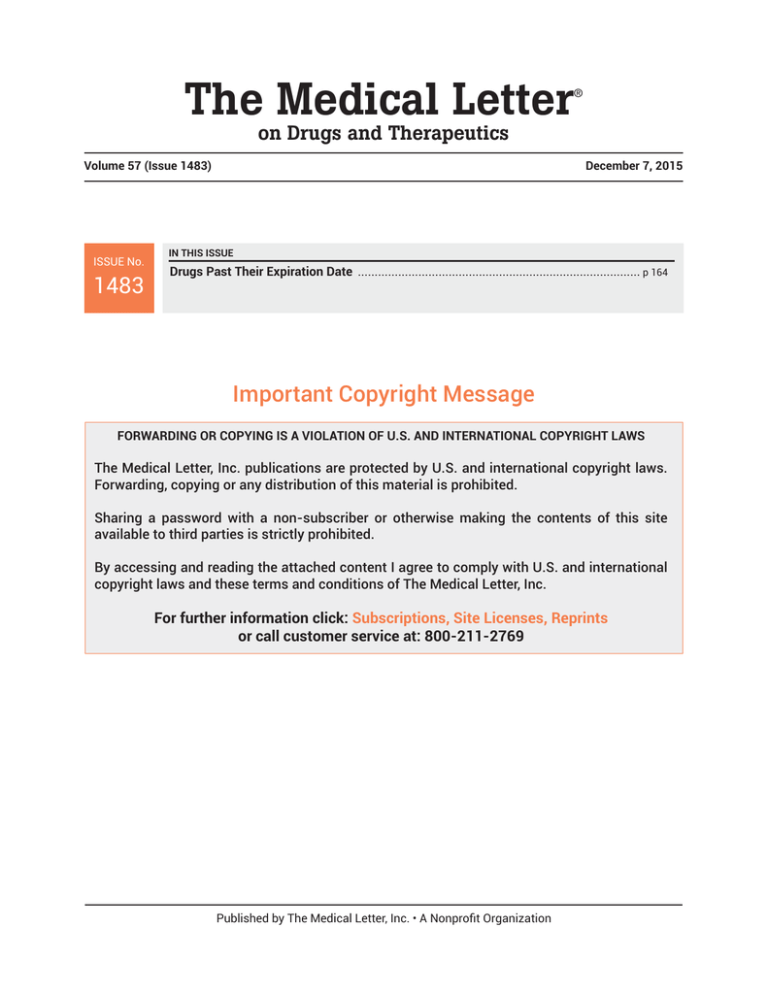
The Medical Letter ® on Drugs and Therapeutics Volume 57 (Issue 1483) ISSUE ISSUE No. 1433 1483 December 7, 2015 IN THIS ISSUE Drugs Past Their Expiration Date .................................................................................... p 164 Volume 56 Important Copyright Message FORWARDING OR COPYING IS A VIOLATION OF U.S. AND INTERNATIONAL COPYRIGHT LAWS The Medical Letter, Inc. publications are protected by U.S. and international copyright laws. Forwarding, copying or any distribution of this material is prohibited. Sharing a password with a non-subscriber or otherwise making the contents of this site available to third parties is strictly prohibited. By accessing and reading the attached content I agree to comply with U.S. and international copyright laws and these terms and conditions of The Medical Letter, Inc. For further information click: Subscriptions, Site Licenses, Reprints or call customer service at: 800-211-2769 Published by The Medical Letter, Inc. • A Nonprofit Organization The Medical Letter ® on Drugs and Therapeutics Volume 57 (Issue 1483) December 7, 2015 Take CME Exams ▶ Drugs Past Their Expiration Date Healthcare providers are often asked if drugs can be used past their expiration date. Because of legal restrictions and liability concerns, manufacturers do not sanction such use and usually do not even comment on the safety or effectiveness of their products beyond the date on the label. Since our last publication on this subject,1 more data have become available. SAFETY — There are no published reports of human toxicity due to ingestion, injection, or topical application of a current drug formulation after its expiration date. Renal tubular damage has been reported with use of degraded tetracycline in a formulation that is no longer available.2 THE EXPIRATION DATE — The manufacturer's expiration date is based on the stability of the drug in the original sealed container. The date does not necessarily mean that the drug was found to be unstable after a longer period; it only means that real-time data or extrapo-lations from accelerated degradation studies indicate that the drug in the closed container will still be stable at that date. Most drug products have a labeled shelf life of 1-5 years, but once the original container is opened, the expiration date on that container no longer applies. STABILITY — Data from the US Department of Defense/ FDA Shelf Life Extension Program, which tests the stability of drug products past their expiration date, have shown that 2650 of 3005 lots (~88%) of 122 different products stored in their unopened original containers remained stable for an average of 66 months after their expiration date.3 Of these, 312 lots (~12%) remained stable for >4 years after the expiration date. Failure on the basis of potency, pH, water content, dissolution, physical appearance, or presence of impurities occurred in 479 lots (~18%), but none failed within 1 year. Potassium iodide, which has been extensively stockpiled for use in a radiation emergency, has shown no significant degradation over many years.4 HEAT, HUMIDITY, AND LONG-TERM STORAGE — Storage in high heat and/or humidity can accelerate the degradation of some drug formulations, but in one study, captopril tablets, theophylline tablets (Theo-Dur, and others), and cefoxitin sodium powder for injection (Mefoxin, and others), stored at 40°C and 75% relative humidity, remained stable for 1.5-9 years beyond their expiration dates.5 In another study, theophylline retained 90% of its potency 30 years past its expiration date.6 A study of eight products that had been stored in their unopened original containers for 28-40 years past expiration found that 12 of 14 active ingredients had retained ≥90% of their original potency; aspirin retained <5% of its potency and amphetamine <60%.7 LIQUID DRUGS — Solutions and suspensions are generally less stable than solid dosage forms, but in one report, four outdated samples of atropine solution (three up to 12 years past expiration and one >50 years past expiration) were all found to contain significant amounts of the drug.8 Drugs in solution that have become cloudy or discolored or show signs of precipitation, particularly injectables, should not be used. Suspensions are especially susceptible to freezing. Limiting factors with ophthalmic drugs include evaporation of the solvent and the continued ability of the preservative to inhibit microbial growth.9 Epinephrine solutions in EpiPen auto-injectors may lose potency after the expiration date. In a study of 34 pens that had expired 1-90 months previously, the decrease in epinephrine content was proportional to the number of months past the expiration date.10 One study found that pens 3-36 months past their expiration dates contained 84.2-101.5% of the labeled dose,11 but a study of pens stored in EMS vehicles that had expired 1-11 years previously found that only 12.6-31.3% of the labeled dose remained.12 No data are available on other epinephrine auto-injectors such as Auvi-Q.13 164 Published by The Medical Letter, Inc. • A Nonprofit Organization The Medical Letter Vol. 57 (1483) ® CONCLUSION — When no suitable alternative is available, outdated drugs may be effective. How much potency they retain varies with the drug, the lot, the preservatives (if any), and the storage conditions, especially heat and humidity; many solid dosage formulations stored under reasonable conditions in their original unopened containers retain ≥90% of their potency for at least 5 years after the expiration date on the label, and sometimes much longer. Solutions and suspensions are generally less stable. There are no reports of toxicity from degradation products of currently available drugs. ■ 1. Drugs past their expiration date. Med Lett Drugs Ther 2009; 51:100. 2. GW Frimpter et al. Reversible “Fanconi syndrome” caused by degraded tetracycline. JAMA 1963; 184:111. 3. RC Lyon et al. Stability profiles of drug products extended beyond labeled expiration dates. J Pharm Sci 2006; 95:1549. 4. US Department of Health and Human Services. Guidance for federal agencies and state and local governments: potassium iodide December 7, 2015 tablets shelf life extension. Available at: www.fda.gov/downloads/ Drugs/Guidances/ucm080549.pdf. Accessed November 24, 2015. 5. G Stark et al. A study of the stability of some commercial solid dosage forms beyond their expiration dates. Pharm J 1997; 258:637. 6. R Regenthal et al. The pharmacologic stability of 35-year old theophylline. Hum Exp Toxicol 2002; 21:343. 7. L Cantrell et al. Stability of active ingredients in long-expired prescription medications. Arch Intern Med 2012; 172:1685. 8. JG Schier et al. Preparing for chemical terrorism: stability of injectable atropine sulfate. Acad Emerg Med 2004; 11:329. 9. GD Novack. Can I use those eyedrops after the expiration date? Ocul Surf 2015; 13:169. 10. FE Simons et al. Outdated EpiPen and EpiPen Jr autoinjectors: past their prime? J Allergy Clin Immunol 2000; 105:1025. 11. O Rachid et al. Epinephrine doses contained in outdated epinephrine auto-injectors collected in a Florida allergy practice. Ann Allergy Asthma Immunol 2015; 114:354. 12. A Stonemen et al. Stability of epinephrine in expired EpiPen products from EMS ambulances. Available at: http://abstracts. aaps.org/Verify/AAPS2014/PosterSubmissions/W5370.pdf. Accessed November 24, 2015. 13. In brief: Auvi-Q – a new epinephrine auto-injector. Med Lett Drugs Ther 2013; 55:13. EDITOR IN CHIEF: Mark Abramowicz, M.D.; EXECUTIVE EDITOR: Gianna Zuccotti, M.D., M.P.H., F.A.C.P., Harvard Medical School; EDITOR: Jean-Marie Pflomm, Pharm.D.; ASSISTANT EDITORS, DRUG INFORMATION: Susan M. Daron, Pharm.D., Corinne Z. Morrison, Pharm.D., Michael P. Viscusi, Pharm.D.; CONSULTING EDITORS: Brinda M. Shah, Pharm.D., F. Peter Swanson, M.D; SENIOR ASSOCIATE EDITOR: Amy Faucard CONTRIBUTING EDITORS: Carl W. Bazil, M.D., Ph.D., Columbia University College of Physicians and Surgeons; Vanessa K. Dalton, M.D., M.P.H., University of Michigan Medical School; Eric J. Epstein, M.D., Albert Einstein College of Medicine; Jane P. Gagliardi, M.D., M.H.S., F.A.C.P., Duke University School of Medicine; David N. Juurlink, BPhm, M.D., Ph.D., Sunnybrook Health Sciences Centre; Richard B. Kim, M.D., University of Western Ontario; Franco M. Muggia, M.D., New York University Medical Center; Sandip K. Mukherjee, M.D., F.A.C.C., Yale School of Medicine; Dan M. Roden, M.D., Vanderbilt University School of Medicine; Esperance A.K. Schaefer, M.D., M.P.H., Harvard Medical School; F. Estelle R. Simons, M.D., University of Manitoba; Neal H. Steigbigel, M.D., New York University School of Medicine; Arthur M. F. Yee, M.D., Ph.D., F.A.C.R., Weill Medical College of Cornell University MANAGING EDITOR: Susie Wong; ASSISTANT MANAGING EDITOR: Liz Donohue; EDITORIAL ASSISTANT: Cheryl Brown EXECUTIVE DIRECTOR OF SALES: Gene Carbona; FULFILLMENT & SYSTEMS MANAGER: Cristine Romatowski; DIRECTOR OF MARKETING COMMUNICATIONS: Joanne F. Valentino; VICE PRESIDENT AND PUBLISHER: Yosef Wissner-Levy Founded in 1959 by Arthur Kallet and Harold Aaron, M.D. Copyright and Disclaimer: The Medical Letter, Inc. is an independent nonprofit organization that provides healthcare professionals with unbiased drug prescribing recommendations. The editorial process used for its publications relies on a review of published and unpublished literature, with an emphasis on controlled clinical trials, and on the opinions of its consultants. The Medical Letter, Inc. is supported solely by subscription fees and accepts no advertising, grants, or donations. No part of the material may be reproduced or transmitted by any process in whole or in part without prior permission in writing. The editors do not warrant that all the material in this publication is accurate and complete in every respect. The editors shall not be held responsible for any damage resulting from any error, inaccuracy, or omission. Subscription Services Address: The Medical Letter, Inc. 145 Huguenot St. Ste. 312 New Rochelle, NY 10801-7537 www.medicalletter.org Get Connected: 165 Customer Service: Call: 800-211-2769 or 914-235-0500 Fax: 914-632-1733 E-mail: [email protected] Permissions: To reproduce any portion of this issue, please e-mail your request to: [email protected] Copyright 2015. ISSN 1523-2859 Subscriptions (US): 1 year - $129; 2 years - $232; 3 years - $345. $65 per year for students, interns, residents, and fellows in the US and Canada. Reprints - $12 each. Site License Inquiries: E-mail: [email protected] Call: 800-211-2769 ext. 315 Special rates available for bulk subscriptions.
